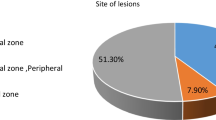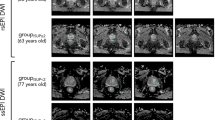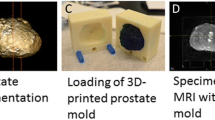Abstract
Purpose
18F-FDG PET/CT is used to characterize many malignancies, but is not recommended for localized prostate cancer. This study explores the value of multi-parametric MRI (mpMRI) in characterizing incidental prostate 18F-FDG uptake.
Methods
Thirty-one patients who underwent 18F-FDG PET/CT for reasons unrelated to prostate cancer and prostate mpMRI were eligible for this retrospective study. The mpMRI included T2-weighted (T2W), dynamic contrast enhancement (DCE), apparent diffusion coefficient (ADC), and MR spectroscopy (MRS) sequences. Fourteen patients were excluded (n = 8 insufficient histopathology, n = 6 radical prostatectomy before PET), and final analysis included 17 patients. A nuclear medicine physician, blinded to clinicopathologic findings, identified suspicious areas and maximum standardized uptake values (SUVmax) on 18F-FDG PET/CT. Sector-based imaging findings were correlated with annotated histopathology from whole-mount or MRI/transrectal ultrasound fusion biopsy samples. Positive predictive values (PPVs) were estimated using generalized estimating equations with logit link. Results were evaluated with Kruskal–Wallis and Dunn’s multiple comparisons tests.
Results
The PPV of 18F-FDG PET alone in detecting prostate cancer was 0.65. Combining 18F-FDG PET as a base parameter with mpMRI (T2W, DCE, ADC, and MRS) increased the PPV to 0.82, 0.83, 0.83, and 0.94, respectively. All benign lesions had SUVmax < 6. Malignant lesions had higher SUVmax values that correlated with Gleason scores. There was a significant difference in SUVmax per prostate between the Gleason ≥ 4 + 5 and benign categories (p = 0.03).
Conclusions
Focal incidental prostate 18F-FDG uptake has low clinical utility alone, but regions of uptake may harbor high-grade prostate cancer, especially if SUVmax > 6. Using mpMRI to further evaluate incidental 18F-FDG uptake aids the diagnosis of prostate cancer.







Similar content being viewed by others
References
Bhosale P, Balachandran A, Vikram R, et al. (2013) What is the clinical significance of FDG unexpected uptake in the prostate in patients undergoing PET/CT for other malignancies ? Int J Mol Imaging . doi:10.1155/2013/476786
Hwang I, Chong A, Jung SI, et al. (2013) Is further evaluation needed for incidental focal uptake in the prostate in 18-fluoro-2-deoxyglucose positron emission tomography-computed tomography images ? Ann Nucl Med 27:140–145
Cho SK, Choi JY, Yoo J, et al. (2011) Incidental focal (18)F-FDG uptake in the prostate: clinical significance and differential diagnostic criteria. Nucl Med Mol Imaging 45:192–196
Han EJ, Ho J, Choi WH, et al. (2010) Significance of incidental focal uptake in prostate on 18-fluoro-2-deoxyglucose positron emission tomography CT images. Br J Radiol 83:915–920
BIO-TECH Report #370 (2014) The Market for PET Radiopharmaceuticals & PET Imaging. http://biotechsystems.com/reports/370/default.asp. Accessed 21 Dec 2014
American Cancer Society (2013) What are the key statistics about prostate cancer? http://www.cancer.org/cancer/prostatecancer/detailedguide/prostate-cancer-key-statistics. Accessed 15 Nov 2014
Jadvar H, Desai B, Ji L, et al. (2013) Baseline 18F-FDG PET/CT parameters as imaging biomarkers of overall survival in castrate-resistant metastatic prostate cancer. J Nucl Med 54:1195–1201
Bartoletti R, Meliani E, Bongini A, et al. (2014) Fluorodeoxyglucose positron emission tomography may aid the diagnosis of aggressive primary prostate cancer: a case series study. Oncol Lett 7:381–386
Mena E, Lindenberg ML, Turkbey BI, et al. (2014) A pilot study of the value of 18 F-fluoro-deoxy-thymidine PET/CT in predicting viable lymphoma in residual F-FDG avid masses after completion of therapy. Clin Nucl Med 39:874–881
Pinto PA, Chung PH, Rastinehad AR, et al. (2011) Magnetic resonance imaging/ultrasound fusion guided prostate biopsy improves cancer detection following transrectal ultrasound biopsy and correlates with multiparametric magnetic resonance imaging. J Urol 186:1281–1285
Shakir NA, George AK, Siddiqui MM, et al. (2014) Identification of threshold prostate-specific antigen levels to optimize the detection of clinically-significant prostate cancer by MRI/US fusion guided biopsy. J Urol 192(6):1642–1648
Shah V, Pohida T, Turkbey B (2009) A method for correlating in vivo prostate magnetic resonance imaging and histopathology using individualized magnetic resonance-based molds. Rev Sci Instrum 80:1–6
Minamimoto R, Uemura H, Sano F, et al. (2011) The potential of FDG-PET/CT for detecting prostate cancer in patients with an elevated serum PSA level. Ann Nucl Med 25:21–27
Seino H, Ono S, Miura H, et al. (2014) Incidental prostate 18F-FDG uptake without calcification indicates the possibility of prostate cancer. Oncol Rep 31:1517–1522
Acknowledgements
This research was made possible through the National Institutes of Health (NIH) Medical Research Scholars Program, a public–private partnership supported jointly by the NIH and generous contributions to the Foundation for the NIH from Pfizer Inc., The Doris Duke Charitable Foundation, The Newport Foundation, The American Association for Dental Research, The Howard Hughes Medical Institute, and the Colgate-Palmolive Company, as well as other private donors. For a complete list, please visit the Foundation website at: http://fnih.org/work/education-training-0/medical-research-scholars-program.
Author information
Authors and Affiliations
Corresponding author
Rights and permissions
About this article
Cite this article
Brown, A.M., Lindenberg, M.L., Sankineni, S. et al. Does focal incidental 18F-FDG PET/CT uptake in the prostate have significance?. Abdom Imaging 40, 3222–3229 (2015). https://doi.org/10.1007/s00261-015-0520-y
Published:
Issue Date:
DOI: https://doi.org/10.1007/s00261-015-0520-y




